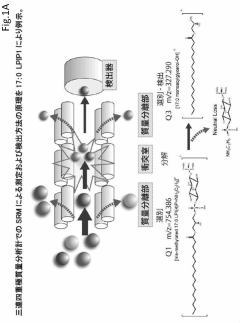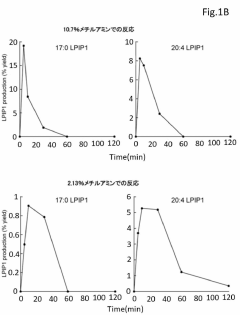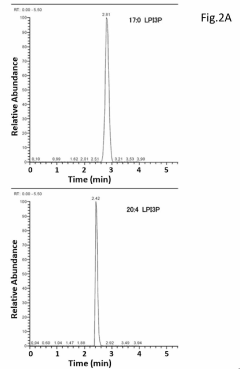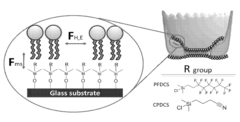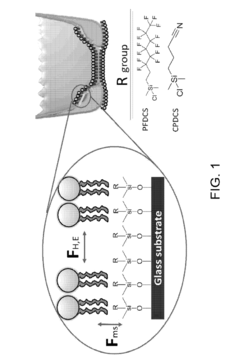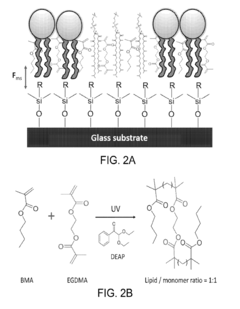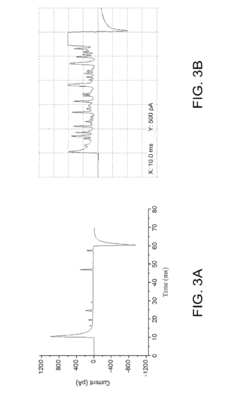Phospholipid Applications in Advanced Math Modeling Techniques
JUL 16, 20259 MIN READ
Generate Your Research Report Instantly with AI Agent
Patsnap Eureka helps you evaluate technical feasibility & market potential.
Phospholipid Modeling Background and Objectives
Phospholipid modeling has emerged as a crucial field in the intersection of biology, chemistry, and advanced mathematics. The evolution of this domain can be traced back to the mid-20th century when researchers began to explore the complex structures and behaviors of biological membranes. Over the decades, the understanding of phospholipids has grown exponentially, driven by advancements in experimental techniques and computational power.
The trajectory of phospholipid modeling has been marked by significant milestones. Initially, simple models treated phospholipids as rigid structures, but as computational capabilities improved, more sophisticated models emerged. These included coarse-grained models, all-atom molecular dynamics simulations, and quantum mechanical approaches. Each step forward has allowed for more accurate representations of phospholipid behavior in various environments.
Recent trends in phospholipid modeling focus on integrating multi-scale approaches, combining atomistic detail with larger-scale phenomena. This integration aims to bridge the gap between molecular-level interactions and macroscopic membrane properties. Additionally, there is a growing emphasis on incorporating machine learning and artificial intelligence techniques to enhance model accuracy and predictive power.
The primary objective of advanced mathematical modeling in phospholipid research is to develop comprehensive, predictive models that can accurately simulate the behavior of phospholipids in diverse biological and synthetic systems. These models aim to capture the complex dynamics of membrane formation, lipid-protein interactions, and the response of phospholipid assemblies to external stimuli.
Specific goals include improving the accuracy of force fields used in molecular dynamics simulations, developing more efficient algorithms for large-scale simulations, and creating models that can predict the properties of novel phospholipid compositions. There is also a strong focus on enhancing the ability to model complex biological processes, such as membrane fusion, vesicle formation, and drug-membrane interactions.
Another critical objective is to create models that can seamlessly integrate experimental data from various sources, including spectroscopy, microscopy, and biophysical assays. This integration aims to create a more holistic understanding of phospholipid behavior and to validate model predictions against real-world observations.
As the field progresses, there is an increasing emphasis on developing models that can be applied to practical challenges in biotechnology, drug delivery, and materials science. The ultimate aim is to use these advanced mathematical techniques to design and optimize phospholipid-based systems for applications ranging from targeted drug delivery to the creation of biomimetic materials.
The trajectory of phospholipid modeling has been marked by significant milestones. Initially, simple models treated phospholipids as rigid structures, but as computational capabilities improved, more sophisticated models emerged. These included coarse-grained models, all-atom molecular dynamics simulations, and quantum mechanical approaches. Each step forward has allowed for more accurate representations of phospholipid behavior in various environments.
Recent trends in phospholipid modeling focus on integrating multi-scale approaches, combining atomistic detail with larger-scale phenomena. This integration aims to bridge the gap between molecular-level interactions and macroscopic membrane properties. Additionally, there is a growing emphasis on incorporating machine learning and artificial intelligence techniques to enhance model accuracy and predictive power.
The primary objective of advanced mathematical modeling in phospholipid research is to develop comprehensive, predictive models that can accurately simulate the behavior of phospholipids in diverse biological and synthetic systems. These models aim to capture the complex dynamics of membrane formation, lipid-protein interactions, and the response of phospholipid assemblies to external stimuli.
Specific goals include improving the accuracy of force fields used in molecular dynamics simulations, developing more efficient algorithms for large-scale simulations, and creating models that can predict the properties of novel phospholipid compositions. There is also a strong focus on enhancing the ability to model complex biological processes, such as membrane fusion, vesicle formation, and drug-membrane interactions.
Another critical objective is to create models that can seamlessly integrate experimental data from various sources, including spectroscopy, microscopy, and biophysical assays. This integration aims to create a more holistic understanding of phospholipid behavior and to validate model predictions against real-world observations.
As the field progresses, there is an increasing emphasis on developing models that can be applied to practical challenges in biotechnology, drug delivery, and materials science. The ultimate aim is to use these advanced mathematical techniques to design and optimize phospholipid-based systems for applications ranging from targeted drug delivery to the creation of biomimetic materials.
Market Analysis for Phospholipid-Based Models
The market for phospholipid-based mathematical models is experiencing significant growth, driven by the increasing demand for advanced modeling techniques in various scientific and industrial sectors. Phospholipids, as essential components of cell membranes, offer unique properties that make them valuable in developing sophisticated mathematical models for biological systems, drug delivery, and materials science.
In the pharmaceutical industry, phospholipid-based models are gaining traction for their ability to simulate drug-membrane interactions and predict drug absorption, distribution, metabolism, and excretion (ADME) properties. This application is particularly crucial in early-stage drug discovery and development, potentially reducing the time and cost associated with bringing new drugs to market. The global pharmaceutical R&D spending, which exceeded $180 billion in 2019, indicates a substantial market potential for these advanced modeling techniques.
The biotechnology sector is another key market for phospholipid-based models. These models are instrumental in understanding cellular processes, protein-lipid interactions, and membrane dynamics. With the global biotechnology market projected to reach $727.1 billion by 2025, the demand for sophisticated modeling tools is expected to grow significantly.
In the field of nanotechnology, phospholipid-based models are essential for designing and optimizing nanocarriers for drug delivery and diagnostic applications. The global nanomedicine market, valued at $160.76 billion in 2019, represents a substantial opportunity for advanced modeling techniques incorporating phospholipids.
The food and beverage industry is also emerging as a potential market for phospholipid-based models. These models can be used to study emulsion stability, encapsulation efficiency, and controlled release of bioactive compounds. With the global functional food market expected to reach $275.77 billion by 2025, there is a growing need for advanced modeling tools to support product development and optimization.
Academic and research institutions constitute another significant market segment for phospholipid-based mathematical models. These models are crucial for advancing fundamental research in biophysics, molecular biology, and materials science. The increasing focus on interdisciplinary research and the growing adoption of computational approaches in life sciences are driving the demand for sophisticated modeling techniques.
Despite the promising market outlook, challenges such as the complexity of model development, the need for specialized expertise, and the high computational requirements may hinder widespread adoption. However, ongoing advancements in artificial intelligence and machine learning are expected to address some of these challenges, potentially expanding the market for phospholipid-based models across various industries.
In the pharmaceutical industry, phospholipid-based models are gaining traction for their ability to simulate drug-membrane interactions and predict drug absorption, distribution, metabolism, and excretion (ADME) properties. This application is particularly crucial in early-stage drug discovery and development, potentially reducing the time and cost associated with bringing new drugs to market. The global pharmaceutical R&D spending, which exceeded $180 billion in 2019, indicates a substantial market potential for these advanced modeling techniques.
The biotechnology sector is another key market for phospholipid-based models. These models are instrumental in understanding cellular processes, protein-lipid interactions, and membrane dynamics. With the global biotechnology market projected to reach $727.1 billion by 2025, the demand for sophisticated modeling tools is expected to grow significantly.
In the field of nanotechnology, phospholipid-based models are essential for designing and optimizing nanocarriers for drug delivery and diagnostic applications. The global nanomedicine market, valued at $160.76 billion in 2019, represents a substantial opportunity for advanced modeling techniques incorporating phospholipids.
The food and beverage industry is also emerging as a potential market for phospholipid-based models. These models can be used to study emulsion stability, encapsulation efficiency, and controlled release of bioactive compounds. With the global functional food market expected to reach $275.77 billion by 2025, there is a growing need for advanced modeling tools to support product development and optimization.
Academic and research institutions constitute another significant market segment for phospholipid-based mathematical models. These models are crucial for advancing fundamental research in biophysics, molecular biology, and materials science. The increasing focus on interdisciplinary research and the growing adoption of computational approaches in life sciences are driving the demand for sophisticated modeling techniques.
Despite the promising market outlook, challenges such as the complexity of model development, the need for specialized expertise, and the high computational requirements may hinder widespread adoption. However, ongoing advancements in artificial intelligence and machine learning are expected to address some of these challenges, potentially expanding the market for phospholipid-based models across various industries.
Current Challenges in Phospholipid Math Modeling
The field of phospholipid math modeling faces several significant challenges that hinder its advancement and widespread application. One of the primary obstacles is the complexity of phospholipid structures and their dynamic behavior in biological systems. Phospholipids exhibit intricate molecular interactions and phase transitions, making it difficult to develop accurate mathematical models that capture their full range of behaviors.
Another challenge lies in the multiscale nature of phospholipid systems. Modeling these systems requires integrating information from molecular to macroscopic scales, which often involves bridging different mathematical frameworks and computational approaches. This integration is particularly challenging when attempting to model the interactions between phospholipids and other biomolecules, such as proteins or nucleic acids.
The heterogeneity of phospholipid compositions in biological membranes presents an additional layer of complexity. Natural membranes contain a diverse array of phospholipid species with varying chain lengths, degrees of saturation, and head group compositions. Accurately representing this diversity in mathematical models while maintaining computational feasibility remains a significant challenge.
Furthermore, the dynamic nature of phospholipid systems poses difficulties in model development and validation. Phospholipids undergo rapid lateral diffusion, flip-flop movements, and other conformational changes that occur on different timescales. Capturing these dynamics in a mathematically tractable manner while preserving physical accuracy is an ongoing challenge in the field.
The lack of comprehensive experimental data for model validation is another hurdle. While advanced experimental techniques have provided valuable insights into phospholipid behavior, obtaining high-resolution, time-resolved data for complex phospholipid systems remains challenging. This limitation hampers the development and refinement of mathematical models, as well as the assessment of their predictive capabilities.
Computational constraints also present significant challenges in phospholipid math modeling. Many advanced modeling techniques, such as molecular dynamics simulations or complex reaction-diffusion models, require substantial computational resources. Balancing model complexity with computational efficiency is a constant struggle, particularly when aiming to simulate large-scale or long-timescale phenomena.
Lastly, the interdisciplinary nature of phospholipid research poses challenges in developing and applying mathematical models. Effective modeling requires collaboration between mathematicians, physicists, chemists, and biologists. Bridging the knowledge gaps between these disciplines and developing a common language for model development and interpretation remains an ongoing challenge in the field.
Another challenge lies in the multiscale nature of phospholipid systems. Modeling these systems requires integrating information from molecular to macroscopic scales, which often involves bridging different mathematical frameworks and computational approaches. This integration is particularly challenging when attempting to model the interactions between phospholipids and other biomolecules, such as proteins or nucleic acids.
The heterogeneity of phospholipid compositions in biological membranes presents an additional layer of complexity. Natural membranes contain a diverse array of phospholipid species with varying chain lengths, degrees of saturation, and head group compositions. Accurately representing this diversity in mathematical models while maintaining computational feasibility remains a significant challenge.
Furthermore, the dynamic nature of phospholipid systems poses difficulties in model development and validation. Phospholipids undergo rapid lateral diffusion, flip-flop movements, and other conformational changes that occur on different timescales. Capturing these dynamics in a mathematically tractable manner while preserving physical accuracy is an ongoing challenge in the field.
The lack of comprehensive experimental data for model validation is another hurdle. While advanced experimental techniques have provided valuable insights into phospholipid behavior, obtaining high-resolution, time-resolved data for complex phospholipid systems remains challenging. This limitation hampers the development and refinement of mathematical models, as well as the assessment of their predictive capabilities.
Computational constraints also present significant challenges in phospholipid math modeling. Many advanced modeling techniques, such as molecular dynamics simulations or complex reaction-diffusion models, require substantial computational resources. Balancing model complexity with computational efficiency is a constant struggle, particularly when aiming to simulate large-scale or long-timescale phenomena.
Lastly, the interdisciplinary nature of phospholipid research poses challenges in developing and applying mathematical models. Effective modeling requires collaboration between mathematicians, physicists, chemists, and biologists. Bridging the knowledge gaps between these disciplines and developing a common language for model development and interpretation remains an ongoing challenge in the field.
State-of-the-Art Phospholipid Modeling Solutions
01 Phospholipid synthesis and extraction methods
Various methods for synthesizing and extracting phospholipids from natural sources or through chemical processes. These techniques aim to produce high-quality phospholipids for use in pharmaceuticals, cosmetics, and food industries.- Phospholipid synthesis and modification: Various methods for synthesizing and modifying phospholipids are described. These include chemical synthesis routes, enzymatic modifications, and novel approaches to create phospholipids with specific properties or functionalities. The processes aim to produce phospholipids for use in pharmaceuticals, cosmetics, and food industries.
- Phospholipid-based drug delivery systems: Phospholipids are utilized in the development of advanced drug delivery systems. These include liposomes, nanoparticles, and other lipid-based carriers that can encapsulate and deliver therapeutic agents. The phospholipid-based systems enhance drug solubility, stability, and targeted delivery to specific tissues or cells.
- Analytical methods for phospholipid characterization: Various analytical techniques and methods are developed for the characterization and quantification of phospholipids. These include chromatographic separations, mass spectrometry, spectroscopic methods, and novel assays. The analytical approaches enable accurate identification and measurement of phospholipids in complex biological samples or formulations.
- Phospholipid applications in food and nutrition: Phospholipids find applications in food and nutrition, including their use as emulsifiers, stabilizers, and functional ingredients. They are incorporated into various food products to improve texture, stability, and nutritional value. Additionally, phospholipids are studied for their potential health benefits and role in dietary supplements.
- Phospholipid-based materials and coatings: Phospholipids are utilized in the development of novel materials and coatings. These include biocompatible surfaces, membranes, and films with applications in medical devices, biosensors, and tissue engineering. The phospholipid-based materials often mimic biological membranes and provide improved biocompatibility and functionality.
02 Phospholipid-based drug delivery systems
Development of drug delivery systems using phospholipids as carriers. These systems enhance drug solubility, stability, and bioavailability, potentially improving therapeutic efficacy and reducing side effects.Expand Specific Solutions03 Phospholipid analysis and characterization techniques
Advanced analytical methods for identifying, quantifying, and characterizing phospholipids in various samples. These techniques include mass spectrometry, chromatography, and spectroscopic methods, enabling detailed structural and compositional analysis of phospholipids.Expand Specific Solutions04 Phospholipid applications in cosmetics and personal care
Utilization of phospholipids in cosmetic and personal care products for their emulsifying, moisturizing, and skin-barrier enhancing properties. These applications include formulations for skincare, haircare, and anti-aging products.Expand Specific Solutions05 Phospholipid-based liposomal formulations
Development of liposomal formulations using phospholipids for encapsulating various active ingredients. These formulations improve stability, controlled release, and targeted delivery of pharmaceuticals, nutraceuticals, and cosmetic actives.Expand Specific Solutions
Key Players in Phospholipid Modeling Research
The phospholipid applications in advanced math modeling techniques market is in an early growth stage, with increasing interest from both academic and industrial sectors. The market size is expanding, driven by the growing demand for sophisticated modeling tools in pharmaceutical, biotechnology, and materials science industries. While the technology is still evolving, it shows promising potential for various applications. Companies like Vascular Biogenics Ltd., Bracco Suisse SA, and NuVessl, Inc. are at the forefront of developing innovative phospholipid-based technologies, indicating a moderate level of technological maturity. Research institutions such as the University of Tokyo and Charité - Universitätsmedizin Berlin are also contributing significantly to advancing the field, suggesting a collaborative ecosystem between industry and academia.
University of Massachusetts
Technical Solution: The University of Massachusetts has developed advanced mathematical modeling techniques for phospholipid applications, focusing on liposome-based drug delivery systems. Their approach combines differential equations and stochastic processes to model the kinetics of drug release from liposomes[1]. They have also implemented machine learning algorithms to predict the optimal lipid composition for specific drug encapsulation and release profiles[3]. Their models incorporate factors such as lipid bilayer permeability, drug solubility, and environmental conditions to provide a comprehensive understanding of liposome behavior in biological systems[5].
Strengths: Comprehensive modeling approach, integration of machine learning. Weaknesses: May require extensive computational resources, potential limitations in real-world applicability.
Ocean University of China
Technical Solution: Ocean University of China has pioneered the use of phospholipid-based mathematical models in marine ecosystem studies. Their approach integrates phospholipid fatty acid (PLFA) analysis with advanced statistical methods to model microbial community dynamics in marine environments[2]. They have developed novel algorithms that use phospholipid profiles as biomarkers to predict changes in marine biodiversity and ecosystem health[4]. Their models also incorporate oceanographic data to simulate the impact of environmental factors on phospholipid distributions in marine organisms[6].
Strengths: Unique application in marine ecosystems, integration of multiple data sources. Weaknesses: May be limited to specific marine environments, potential challenges in model validation.
Innovative Approaches in Phospholipid Mathematics
Development of new phospholipids, their uses, and phospholipid separation measurement methods
PatentInactiveJP2022118008A
Innovation
- A novel method using mass spectrometry combined with chromatography or ion mobility separation allows for the separation, measurement, and identification of phosphoinositides and lysophosphoinositides, preserving the acyl groups and localizing phosphate groups, enabling the detection of previously unknown lysophosphatidylinositol phosphates (LPIPs).
Systems and methods of preparing stabilized lipid assemblies
PatentActiveUS20170120218A1
Innovation
- The introduction of small polymerizable hydrophobic monomers, such as butylmethacrylate and ethylene glycol dimethacrylate, into the lipid bilayer, followed by UV photopolymerization, creates a cross-linked polymer scaffold that enhances the stability of BLMs, and the use of a redox mixture with ammonium persulfate and NaHSO3 for polymerizing phospholipid bilayers at neutral pH conditions preserves protein activity.
Interdisciplinary Applications of Phospholipid Models
Phospholipid models have found extensive applications across various scientific disciplines, demonstrating their versatility and importance in advanced mathematical modeling techniques. In the field of biophysics, these models have been instrumental in simulating membrane dynamics and protein-lipid interactions. Researchers have utilized phospholipid-based models to study the formation and behavior of lipid bilayers, providing insights into cellular processes and drug delivery mechanisms.
In pharmaceutical sciences, phospholipid models have been employed to optimize drug formulations and predict drug-membrane interactions. These models have enabled scientists to develop more effective drug delivery systems by simulating the behavior of lipid-based carriers in different physiological environments. The integration of phospholipid models with machine learning algorithms has further enhanced the predictive capabilities in drug discovery and development processes.
Environmental scientists have adapted phospholipid models to study the fate and transport of pollutants in aquatic ecosystems. By incorporating phospholipid-based parameters into environmental fate models, researchers have improved the accuracy of predictions regarding the bioaccumulation and biodegradation of organic contaminants in water bodies. This application has significant implications for assessing ecological risks and developing remediation strategies.
In the realm of materials science, phospholipid models have been utilized to design and optimize biomimetic materials. Engineers have leveraged these models to develop self-assembling nanostructures and smart materials with tunable properties. The ability to simulate phospholipid behavior at the molecular level has led to advancements in the creation of biocompatible coatings, drug-eluting implants, and tissue engineering scaffolds.
Computational chemists have employed phospholipid models in conjunction with molecular dynamics simulations to study complex chemical systems. These models have been particularly useful in investigating the interactions between small molecules and lipid membranes, providing valuable insights into the mechanisms of membrane permeation and drug-target interactions. The integration of phospholipid models with quantum mechanical calculations has further expanded their applicability in predicting chemical reactivity and spectroscopic properties.
In the field of nanotechnology, phospholipid models have played a crucial role in the design and optimization of liposomal nanocarriers. These models have enabled researchers to predict the stability, drug loading capacity, and release kinetics of nanoparticles under various conditions. The application of phospholipid models in this domain has accelerated the development of targeted drug delivery systems and theranostic nanoplatforms for personalized medicine.
In pharmaceutical sciences, phospholipid models have been employed to optimize drug formulations and predict drug-membrane interactions. These models have enabled scientists to develop more effective drug delivery systems by simulating the behavior of lipid-based carriers in different physiological environments. The integration of phospholipid models with machine learning algorithms has further enhanced the predictive capabilities in drug discovery and development processes.
Environmental scientists have adapted phospholipid models to study the fate and transport of pollutants in aquatic ecosystems. By incorporating phospholipid-based parameters into environmental fate models, researchers have improved the accuracy of predictions regarding the bioaccumulation and biodegradation of organic contaminants in water bodies. This application has significant implications for assessing ecological risks and developing remediation strategies.
In the realm of materials science, phospholipid models have been utilized to design and optimize biomimetic materials. Engineers have leveraged these models to develop self-assembling nanostructures and smart materials with tunable properties. The ability to simulate phospholipid behavior at the molecular level has led to advancements in the creation of biocompatible coatings, drug-eluting implants, and tissue engineering scaffolds.
Computational chemists have employed phospholipid models in conjunction with molecular dynamics simulations to study complex chemical systems. These models have been particularly useful in investigating the interactions between small molecules and lipid membranes, providing valuable insights into the mechanisms of membrane permeation and drug-target interactions. The integration of phospholipid models with quantum mechanical calculations has further expanded their applicability in predicting chemical reactivity and spectroscopic properties.
In the field of nanotechnology, phospholipid models have played a crucial role in the design and optimization of liposomal nanocarriers. These models have enabled researchers to predict the stability, drug loading capacity, and release kinetics of nanoparticles under various conditions. The application of phospholipid models in this domain has accelerated the development of targeted drug delivery systems and theranostic nanoplatforms for personalized medicine.
Ethical Considerations in Phospholipid Modeling
The ethical considerations in phospholipid modeling are of paramount importance as this field continues to advance and intersect with various domains of science and technology. As researchers and practitioners delve deeper into the applications of phospholipids in advanced mathematical modeling techniques, it becomes crucial to address the ethical implications that arise from these developments.
One of the primary ethical concerns revolves around the potential misuse of phospholipid modeling in biological and medical research. While these models can provide valuable insights into cellular processes and drug interactions, there is a risk that the information could be exploited for harmful purposes, such as the development of biological weapons or the manipulation of genetic material. Researchers must exercise extreme caution and adhere to strict ethical guidelines to prevent such misuse.
Privacy and data protection present another significant ethical challenge in phospholipid modeling. As models become more sophisticated and capable of processing vast amounts of biological data, there is an increased risk of compromising individual privacy. Researchers must implement robust safeguards to protect sensitive information and ensure that data used in modeling is anonymized and securely stored.
The potential for bias in phospholipid modeling algorithms is an ethical concern that requires careful consideration. If models are trained on limited or skewed datasets, they may produce results that disproportionately favor certain populations or lead to discriminatory outcomes in medical treatments. It is essential to strive for diverse and representative data sources to mitigate these biases and ensure equitable applications of the technology.
Transparency and reproducibility in phospholipid modeling research are critical ethical considerations. Researchers have a responsibility to clearly communicate their methodologies, assumptions, and limitations to allow for peer review and validation. This openness not only promotes scientific integrity but also enables the broader scientific community to build upon and improve existing models.
The ethical use of animal models in phospholipid research must also be addressed. While animal studies can provide valuable insights, researchers must carefully weigh the potential benefits against the ethical concerns of animal welfare. Alternatives to animal testing, such as in vitro models and computer simulations, should be explored and utilized whenever possible.
As phospholipid modeling techniques become more integrated into decision-making processes in healthcare and drug development, there is an ethical imperative to ensure that these models are used responsibly and do not replace human judgment entirely. Practitioners must be trained to interpret model outputs critically and understand their limitations to avoid over-reliance on automated systems.
Finally, the equitable distribution of the benefits derived from phospholipid modeling advancements is an important ethical consideration. Efforts should be made to ensure that these technologies are accessible to researchers and healthcare providers globally, particularly in resource-limited settings, to prevent exacerbating existing health disparities.
One of the primary ethical concerns revolves around the potential misuse of phospholipid modeling in biological and medical research. While these models can provide valuable insights into cellular processes and drug interactions, there is a risk that the information could be exploited for harmful purposes, such as the development of biological weapons or the manipulation of genetic material. Researchers must exercise extreme caution and adhere to strict ethical guidelines to prevent such misuse.
Privacy and data protection present another significant ethical challenge in phospholipid modeling. As models become more sophisticated and capable of processing vast amounts of biological data, there is an increased risk of compromising individual privacy. Researchers must implement robust safeguards to protect sensitive information and ensure that data used in modeling is anonymized and securely stored.
The potential for bias in phospholipid modeling algorithms is an ethical concern that requires careful consideration. If models are trained on limited or skewed datasets, they may produce results that disproportionately favor certain populations or lead to discriminatory outcomes in medical treatments. It is essential to strive for diverse and representative data sources to mitigate these biases and ensure equitable applications of the technology.
Transparency and reproducibility in phospholipid modeling research are critical ethical considerations. Researchers have a responsibility to clearly communicate their methodologies, assumptions, and limitations to allow for peer review and validation. This openness not only promotes scientific integrity but also enables the broader scientific community to build upon and improve existing models.
The ethical use of animal models in phospholipid research must also be addressed. While animal studies can provide valuable insights, researchers must carefully weigh the potential benefits against the ethical concerns of animal welfare. Alternatives to animal testing, such as in vitro models and computer simulations, should be explored and utilized whenever possible.
As phospholipid modeling techniques become more integrated into decision-making processes in healthcare and drug development, there is an ethical imperative to ensure that these models are used responsibly and do not replace human judgment entirely. Practitioners must be trained to interpret model outputs critically and understand their limitations to avoid over-reliance on automated systems.
Finally, the equitable distribution of the benefits derived from phospholipid modeling advancements is an important ethical consideration. Efforts should be made to ensure that these technologies are accessible to researchers and healthcare providers globally, particularly in resource-limited settings, to prevent exacerbating existing health disparities.
Unlock deeper insights with Patsnap Eureka Quick Research — get a full tech report to explore trends and direct your research. Try now!
Generate Your Research Report Instantly with AI Agent
Supercharge your innovation with Patsnap Eureka AI Agent Platform!
